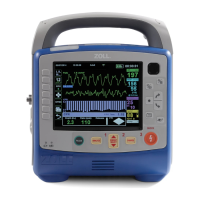Warnings
9650-001355-01 Rev. M X Series Operator’s Guide 1-23
• Disconnect all electro-medical equipment that is not defibrillation-protected from the
patient prior to defibrillation.
• Before discharging the defibrillator, warn everyone to STAND CLEAR of the patient.
• Do not touch the bed, patient, or any equipment connected to the patient during
defibrillation. A severe shock can result. To avoid hazardous pathways for the defibrillation
current, do not allow exposed portions of the patient's body to touch any metal objects, such
as a bed frame.
• To avoid risk of electrical shock, do not allow printer to come into contact with other
conducive parts, such as equipment connected to the USB port.
Patient Safety
• Inappropriate defibrillation or cardioversion of a patient (for example, with no malignant
arrhythmia) may precipitate ventricular fibrillation, asystole, or other dangerous
arrhythmias.
• Defibrillation without proper application of electrodes or paddle electrolyte gel might be
ineffective and cause burns, particularly when repeated shocks are necessary. Erythema or
hyperemia of the skin under the paddles, or electrodes often occurs; this effect is usually
enhanced along the perimeter of the paddles or electrodes. This reddening should diminish
substantially within 72 hours.
• This equipment should be connected to only one patient at a time.
• Use only OneStep Pediatric electrodes to defibrillate patients under 8 years of age. Use of
adult electrodes, or pediatric electrodes other than OneStep Pediatric electrodes, can result
in the delivery of excessive energy doses.
• Neonatal and pediatric defibrillation energy level settings should be based on site-specific
clinical protocols.
• To ensure patient safety, do not place the monitor in any position that might cause it to fall
on the patient.
• To ensure patient safety, connect the X Series only to equipment with circuits that are
electrically isolated.
• Use only high-quality ECG electrodes. ECG electrodes are for rhythm acquisition only; you
cannot use ECG electrodes for defibrillation or pacing.
• Do not use therapy or ECG electrodes if the gel is dried, separated, torn or split from the
foil; patient burns may result from using such electrodes. Poor adherence and/or air pockets
under therapy electrodes can cause arcing and skin burns.
• Check the expiration date on the electrode packaging. Do not use electrodes after their
expiration date.
• Excessive body hair or wet, diaphoretic skin can inhibit electrode coupling to the skin. Clip
excess hair and dry any moisture from the area where an electrode is to be attached.
• Therapy electrodes should be replaced periodically during continuous pacing. Consult
electrode directions for proper replacement instructions.
• Prolonged pacing (more than 30 minutes), particularly in neonates or adults with severely
restricted blood flow, may cause burns. Periodically inspect the skin under the electrodes.
• Carefully route the patient cables away from the patient’s neck to reduce the possibility of
patient entanglement or strangulation.
• To avoid electrosurgery burns at monitoring sites, ensure proper connection of the
electrosurgery return circuit so that a return path cannot be made through monitoring
electrodes or probes.
• During electrosurgery, observe the following guidelines to minimize electrosurgery unit
(ESU) interference and provide maximum operator and patient safety:
• Keep all patient monitoring cables away from earth ground, ESU knives, and ESU
return wires.
• Use electrosurgical grounding pads with the largest practical contact area.
• Always ensure proper application of the electrosurgical return electrode to the patient.
• Check electrical leakage levels before use. Leakage current might be excessive if more than
one monitor or other piece of equipment is connected to the patient.

